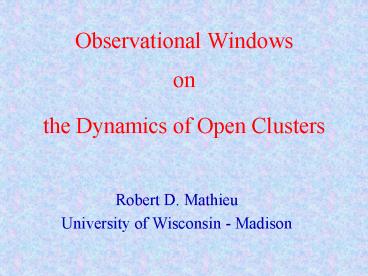Observational Windows on the Dynamics of Open Clusters - PowerPoint PPT Presentation
Title:
Observational Windows on the Dynamics of Open Clusters
Description:
Comprehensive and definitive photometric, astrometric, and spectroscopic ... Tidal Circularization Rates. NGC 188 7 Gyr Pcutoff = 14.9 days. Mathieu et al. 2004 ... – PowerPoint PPT presentation
Number of Views:31
Avg rating:3.0/5.0
Title: Observational Windows on the Dynamics of Open Clusters
1
Observational Windowsonthe Dynamics of Open
Clusters
- Robert D. Mathieu
- University of Wisconsin - Madison
2
Typical Open Cluster M 300 Mo Rc 1 pc Rt
20 pc s 0.3 km s-1 rc 10 Mo pc-3
3
WIYN Open Cluster Study
- Comprehensive and definitive photometric,
astrometric, and spectroscopic databases for new
fundamental open clusters. - A body of investigations which address critical
astrophysical problems through study of open
clusters.
4
WOCS Senior Scientists
- C. Deliyannis Indiana photometry, spectroscopy,
abundances - P. Demarque Yale theoretical stellar evolution
- T. Girard Yale astrometry, proper motions
- K. Honeycutt Indiana photometric monitoring,
compact binaries - R. Mathieu Wisconsin radial velocities, binary
populations - I. Platais JHU astrometry, proper motions,
photometry - A. Sarajedini Florida photometry, stellar
evolution - W. van Altena Yale astrometry, proper motions
- T. von Hippel Texas photometry, luminosity
functions
5
WOCS Clusters
Log Age (Gyrs)
First Generation
6
WOCS Strategy
- Imaging/Photometry
- Deep UBVRI images of cluster cores
- UBVRI wide-field surveys to tidal radii
- Photometric monitoring for variability
- Astrometry
- Precise stellar positions
- Deep, wide-field proper motions
- Spectroscopy
- Abundance determinations
- Metallicity, CNO, and lithium
- Precise radial velocities
- Projected rotation velocities
- Stellar activity
7
NGC 188 1840 pc E(B-V) 0.04 7 Gyr Fe/H
-0.12 1000 Mo (d 85o)
8
Photometry Precision 0.012 mag
(BVRI) 0.03 mag (U) Accuracy
0.02 mag (BVRI)
Sarajedini et al. 1999 WOCS II
9
Photometry
Von Hippel et al. 1999 WOCS I
10
Proper Motions 0.15 mas yr-1 Positions 0.2
mas 7812 objects V21 0.75 deg2
Platais et al. 2004 WOCS XVII
11
(No Transcript)
12
Radial Velocities 0.4 km s-1 500 VR/night V lt
16.5 0.75 deg2 (WIYN 3.5m)
13
VR
14
93 spectroscopic binaries 55 orbital solutions P
lt 3000d
Mathieu et al. 2004 WOCS XVIII
15
Outcomes for Stellar Dynamics
- Superb 3-dimensional membership determination
- for entire evolved cluster population to beyond
tidal radius - Reliable 2-dimensional membership determination
- to 0.5 Mo and beyond tidal radius
- Photometric mass function to 0.1 Mo in cluster
core - Complete census of short-period, solar-type
binary population, - with orbital elements
16
The Interface of Two Classical FieldsStellar
Astrophysics and Stellar Dynamics
17
M67 4.5 Gyr Fe/H -0.04 1000 Mo
1.3 Mo
18
Binary Frequency
Spectroscopic Binaries
For P lt 1000d M67 19 4 Field 16 3
Mathieu, Latham Griffin 1990 Mathieu et
al. 2004
19
Mathieu et al. 2003
S1063 P18.4 d e 0.21 g 34.3 km/s pm 97
S1113 P2.8 d e 0 g 33.4 km/s pm 98
20
Tidal Circularization Rates
21
NGC 188 7 Gyr Pcutoff 14.9 days
Mathieu et al. 2004
22
Meibom Mathieu 2004
23
Opening Thoughtson Choice of Open Cluster(s)
24
WOCS Clusters
Log Age (Gyrs)
First Generation
25
Optimal Cluster Properties (with an
observational bias)
- Rich several thousand members to 0.1 Mo
- evolution without complete evaporation
- meaningful statistics
- Old age greater than 1 Gyr
- multiple relaxation times
- solar-mass evolution
- Nearby d lt 2 kpc
- accessible main-sequence binary population
- Accessible -20o lt d lt 20o
- observable from both hemispheres
- Out of Plane b gt 10o
- minimize field-star contamination, especially at
Rt































